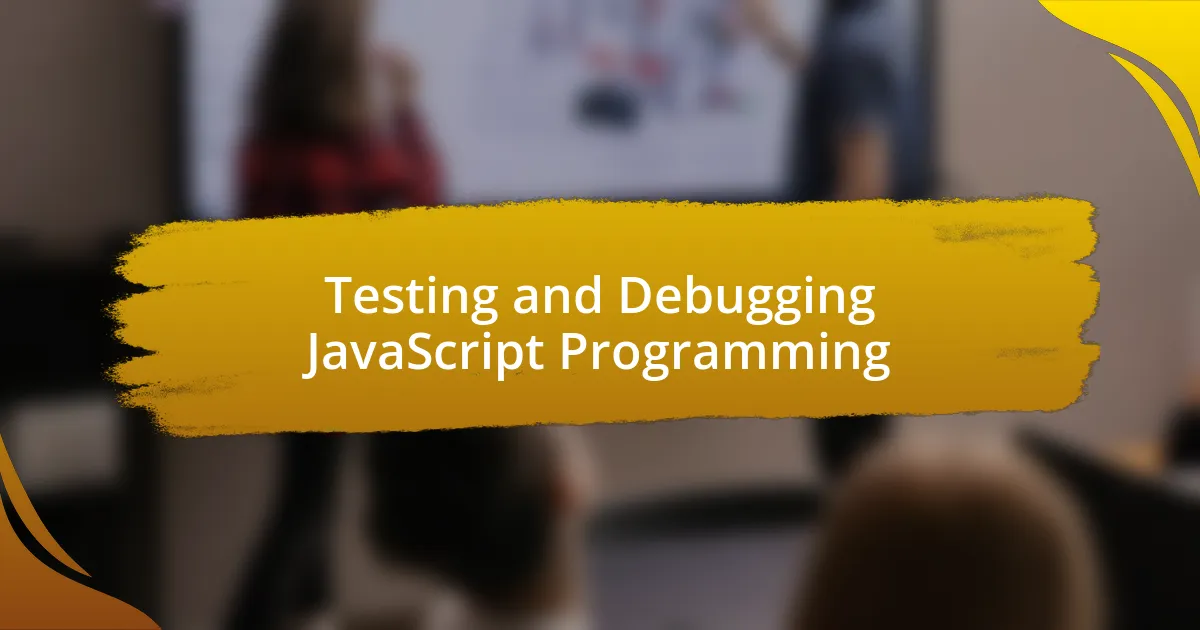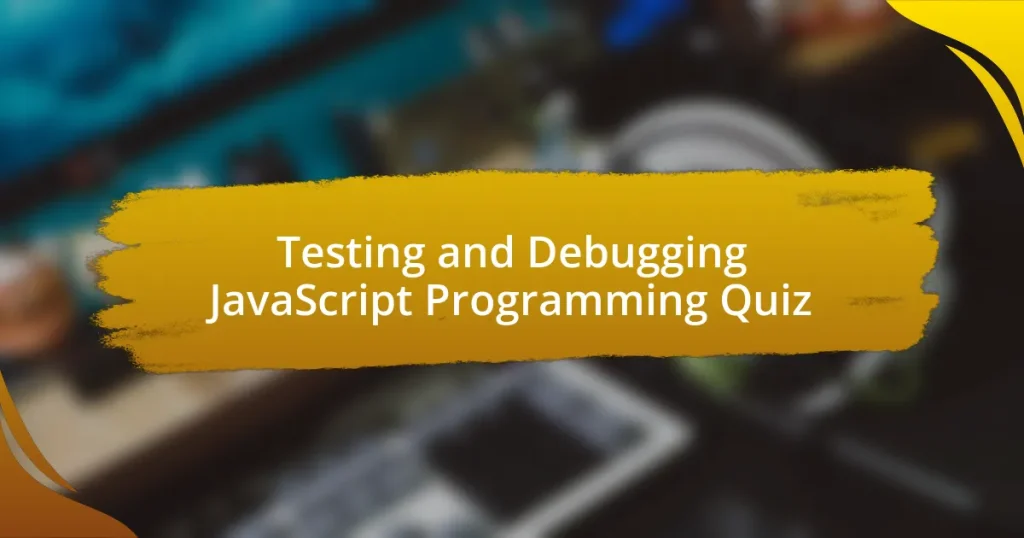
Start of Testing and Debugging JavaScript Programming Quiz
1. What is the first step in debugging JavaScript code?
- Understand the Problem
- Skip to Testing
- Ask for Help
- Change the Code
2. What technique involves dividing the problem into smaller parts to solve it?
- Split and Fix
- Break and Solve
- Analyze and Repair
- Divide and Conquer
3. Which tool is primarily used to inspect variables in JavaScript?
- Database Management System
- Text Editor
- Command Line Interface
- Browser Developer Tools
4. What is the purpose of assertions in unit tests for JavaScript?
- To ensure the code behaves as expected
- To slow down the execution of the code
- To avoid handling errors during runtime
- To generate random values for testing
5. How can you review error messages in JavaScript?
- By writing console.error in every function
- By using the alert() function to display messages
- By examining the console output and stack trace logs
- By checking JavaScript files for syntax errors manually
6. Which function prints messages to the console in JavaScript?
- print.console()
- log.output()
- echo.message()
- console.log()
7. How do you set a breakpoint in JavaScript code?
- By using an alert statement before the line
- By clicking on the line number in the Sources panel of the developer tools
- By writing `breakpoint` in the code
- By adding a comment above the line of code
8. What is the role of try…catch blocks in error handling?
- To automatically fix all coding mistakes
- To convert errors into warnings
- To catch and handle runtime errors
- To ignore errors and continue execution
9. How is the debugger statement utilized in JavaScript?
- By commenting out the code
- By running the code in an alert box
- By invoking the browser’s debugger tool
- By using console.log() exclusively
10. What is the typical approach to using developer tools for debugging?
- Write down error messages and ignore code context
- Open developer tools, navigate to Sources panel, set breakpoint, refresh webpage, and inspect variables
- Remove all code and start from scratch
- Run the code without checking for errors
11. What is the correct syntax for using console.log() in JavaScript?
- console.log(`message`);
- console.log[](`message`);
- console.log.message(`message`);
- log.console(`message`);
12. How can console.log() help identify bugs in your JavaScript code?
- By printing out messages or checking variable values
- By running the code on a different platform
- By hiding error messages from the user
- By creating random variables in the code
13. What are conditional breakpoints used for in debugging?
- To pause execution only when a specific condition is met
- To permanently stop the program from running
- To record all variable values during execution
- To continue execution without interruptions
14. How do you create a conditional breakpoint in JavaScript?
- By stopping the execution after every line of code
- By adding comments in the code to pause execution
- By using the debugger statement in your code
- By specifying a condition in the breakpoint settings
15. Why is setting breakpoints on event listeners beneficial?
- To automatically correct any bugs in the code
- To eliminate all potential errors in the code
- To speed up the processing of the event listeners
- To pause code execution and examine the state of the program at a specific moment
16. How do you apply a breakpoint on an event listener in JavaScript?
- By adding a debug flag in the event listener function
- By using console.log() to observe event triggers
- By clicking the Sources tab, expanding the event listener, and setting a breakpoint
- By changing the event listener to pause on click
17. What controls does the Chrome debugger provide for navigating code?
- Step, Step Over, Step Into, Out, and Resume
- Debug, Trace, Analyze, Skip, and Pause
- Run, Launch, Edit, Stop, and Execute
- Log, Print, Save, Exit, and Return
18. What function does the Step control serve in the Chrome debugger?
- It allows you to jump to the end of the script immediately.
- It enables you to step through line by line as the JavaScript code executes.
- It pauses the execution indefinitely.
- It skips over lines without executing them.
19. How does the Step Over control work in the Chrome debugger?
- It steps into a function call to examine details.
- It executes a function without stepping into it.
- It resumes code execution after pausing.
- It allows you to skip past a line of code entirely.
20. What is the purpose of the Step Into control in debugging?
- It skips the function and moves to the next line
- It stops the debugging session altogether
- It exits the entire program immediately
- It steps into a function call and executes it line by line
21. What does the Step Out control do in the Chrome debugger?
- It steps out of a function call after executing it line by line.
- It executes a function without stepping into it.
- It resumes execution of the code from the current breakpoint.
- It enables you to step through line by line as the JavaScript code executes.
22. What action does the Resume control perform in code execution?
- It saves the current state of the code execution
- It skips the current line and moves to the next
- It resumes execution of the code from the current breakpoint
- It stops execution and resets the code
23. How can you log and analyze data during debugging in JavaScript?
- By storing data in localStorage and retrieving it later
- By using console.log() to print out data and examining it in the console
- By using alert() to show data in pop-ups during execution
- By writing data directly to the HTML document with document.write()
24. Why is consulting documentation important in debugging?
- To distract from the main issues in the code
- To add unnecessary complexity to the process
- To eliminate the need for testing and error checking
- To find solutions to specific problems and understand how to use debugging tools
25. How can code isolation aid in debugging?
- By avoiding any interaction with debugging tools
- By combining different code sections into a single block
- By making all code run simultaneously for performance
- By isolating parts of the code to test them individually
26. What advantage does seeking fresh perspectives provide in debugging?
- To work faster without checking details
- To ignore feedback and stick to original solutions
- To get new insights and approaches to solving the problem
- To ensure all team members make the same mistakes
27. How can assertions be effectively used in debugging JavaScript?
- By minimizing the size of the code to avoid errors
- By commenting out all the code and re-running it
- By adding statements that check for certain conditions and throw errors if they are not met
- By running multiple copies of the same function
28. What role do unit tests play in the debugging process?
- To ensure that individual units of code behave as expected
- To improve code readability and maintainability
- To compile the entire project into a final executable
- To document the development process for future reference
29. How can you identify and fix bugs through testing in JavaScript?
- By reading through requirements, identifying bugs, and making iterative changes to fix them
- By solely relying on third-party libraries for solutions
- By ignoring error messages and testing only manually
- By rewriting the entire code from scratch
30. What are the critical skills assessed by the JavaScript debugging skills test?
- Analyze design patterns, enhance styling, create unit tests, and maximize speed
- Write comments, compile code, optimize performance, and avoid errors
- Review project requirements, conduct user testing, manage versions, and refactor code
- Identify bugs, understand the code’s main function, fix bugs, and find solutions within a time limit

Congratulations on Completing the Quiz!
You’ve successfully completed the quiz on Testing and Debugging JavaScript Programming. We hope you enjoyed the process and found it enlightening. This quiz was designed to reinforce your understanding of crucial concepts related to testing and debugging in JavaScript. Every question aimed to clarify key techniques and best practices that can enhance your programming skills.
Throughout this quiz, you may have learned about different debugging tools, testing frameworks, and strategies for identifying bugs in your code. These insights are vital for writing clean, efficient, and error-free JavaScript. Understanding these concepts can significantly improve your development workflow, making your coding experience smoother and more productive.
To deepen your knowledge further, we invite you to explore the next section on this page. It offers additional resources and detailed information on Testing and Debugging JavaScript Programming. This complementary material will provide you with more examples, explanations, and tips to master these essential skills. Dive in and continue enhancing your programming expertise!

Testing and Debugging JavaScript Programming
Understanding Testing in JavaScript Programming
Testing in JavaScript programming involves evaluating code functionality to ensure it behaves as expected. This can include unit testing, integration testing, and end-to-end testing. Unit testing focuses on individual components or functions. Integration testing checks how different parts of the application work together. End-to-end testing simulates user scenarios, testing the application as a whole. Effective testing helps prevent bugs and enhances code reliability by validating that each part functions correctly.
Common Debugging Techniques in JavaScript
Debugging in JavaScript is the process of identifying and resolving errors in code. Common techniques include using console.log() to output variable values at various stages, investigating the call stack to understand how functions are being invoked, and using breakpoints in browser developer tools to pause execution. These methods help pinpoint where the code deviates from expected behavior, facilitating faster issue resolution.
Popular Testing Frameworks for JavaScript
Various frameworks support testing in JavaScript, including Jest, Mocha, and Jasmine. Jest is known for its simplicity and built-in mocking capabilities. Mocha provides a flexible structure for organizing tests, while Jasmine offers a behavior-driven development approach. These frameworks streamline the testing process, enabling developers to write reliable tests with ease and efficiency.
Using Browser Developer Tools for Debugging
Browser developer tools are essential for debugging JavaScript applications. These tools, available in browsers like Chrome and Firefox, include features like the JavaScript console, element inspector, and network monitor. The console allows for real-time code execution and error messages display. The element inspector helps examine HTML and CSS in relation to JavaScript. The network monitor tracks resource loading, assisting in the identification of performance issues.
Best Practices for JavaScript Testing and Debugging
Implementing best practices in JavaScript testing and debugging enhances code quality. Practices include writing clear, concise tests that cover various scenarios, using version control to track changes, and regularly refactoring code to improve clarity. Establishing a test-driven development (TDD) approach encourages writing tests before coding functionality. These practices lead to a more reliable codebase and foster efficient debugging processes.
What is testing in JavaScript programming?
Testing in JavaScript programming refers to the process of executing code to identify bugs or errors. It ensures that the code performs as expected under various conditions. Testing can be automated or manually conducted. Common frameworks for testing in JavaScript include Jest and Mocha. Testing is a critical part of software development, as it helps maintain code quality and reliability.
How do you debug JavaScript code?
To debug JavaScript code, developers use various tools and techniques. One primary method is using the debugging features built into web browsers, such as Chrome Developer Tools. These tools allow developers to set breakpoints, inspect variables, and step through code. Additionally, console.log statements are often used to output variable states and identify issues. This systematic approach helps isolate and fix problems efficiently.
Where can you find resources for JavaScript testing frameworks?
Resources for JavaScript testing frameworks can be found on official websites, online documentation, and developer communities. The official documentation for frameworks like Jest and Mocha provides comprehensive guides and examples. Platforms like GitHub and Stack Overflow also offer user-generated content, such as troubleshooting tips and usage scenarios. These resources illustrate best practices and promote effective use of testing frameworks.
When should you perform testing in JavaScript programming?
Testing in JavaScript programming should be performed at multiple stages throughout the development process. It is essential during initial code writing to catch issues early. Additionally, testing should occur after significant changes in the codebase, following the implementation of new features, or before releasing updates. This approach minimizes regressions and ensures functional integrity.
Who is responsible for testing JavaScript code?
Testing JavaScript code is typically the responsibility of developers and quality assurance (QA) teams. Developers are often the first line of defense, as they write tests while developing features. QA teams may conduct further testing to validate functionality across different scenarios. Collaborative efforts between developers and testers ensure comprehensive coverage and reliability of the code.
















